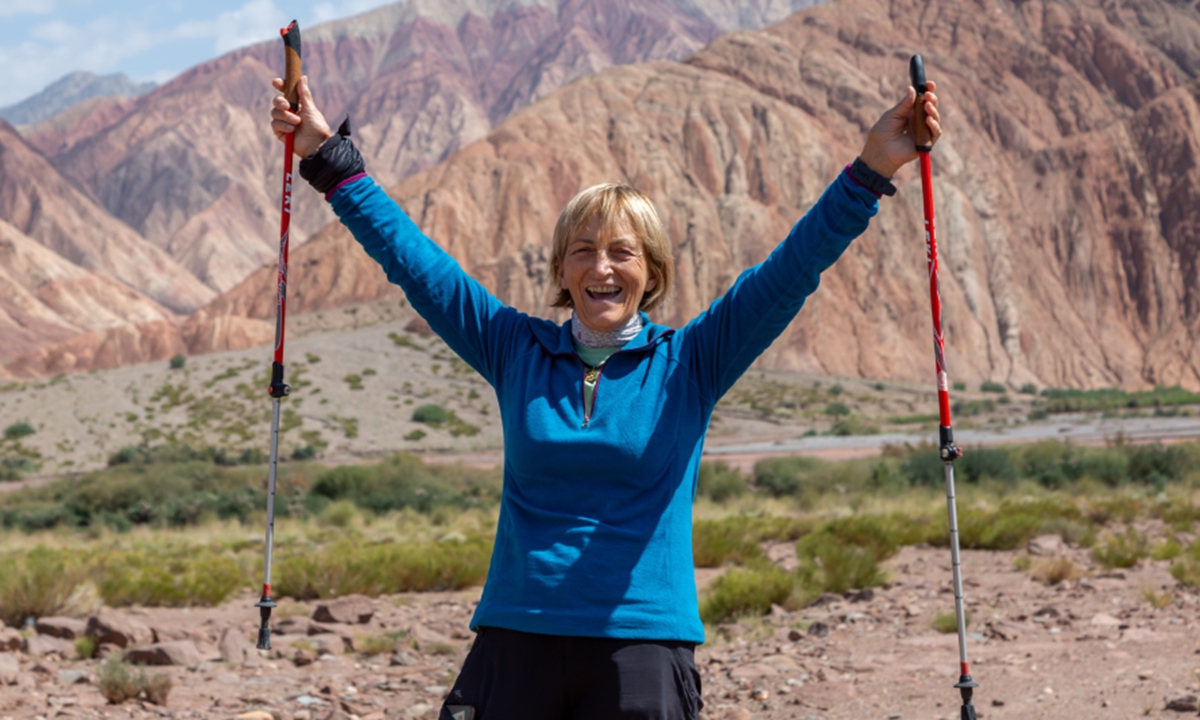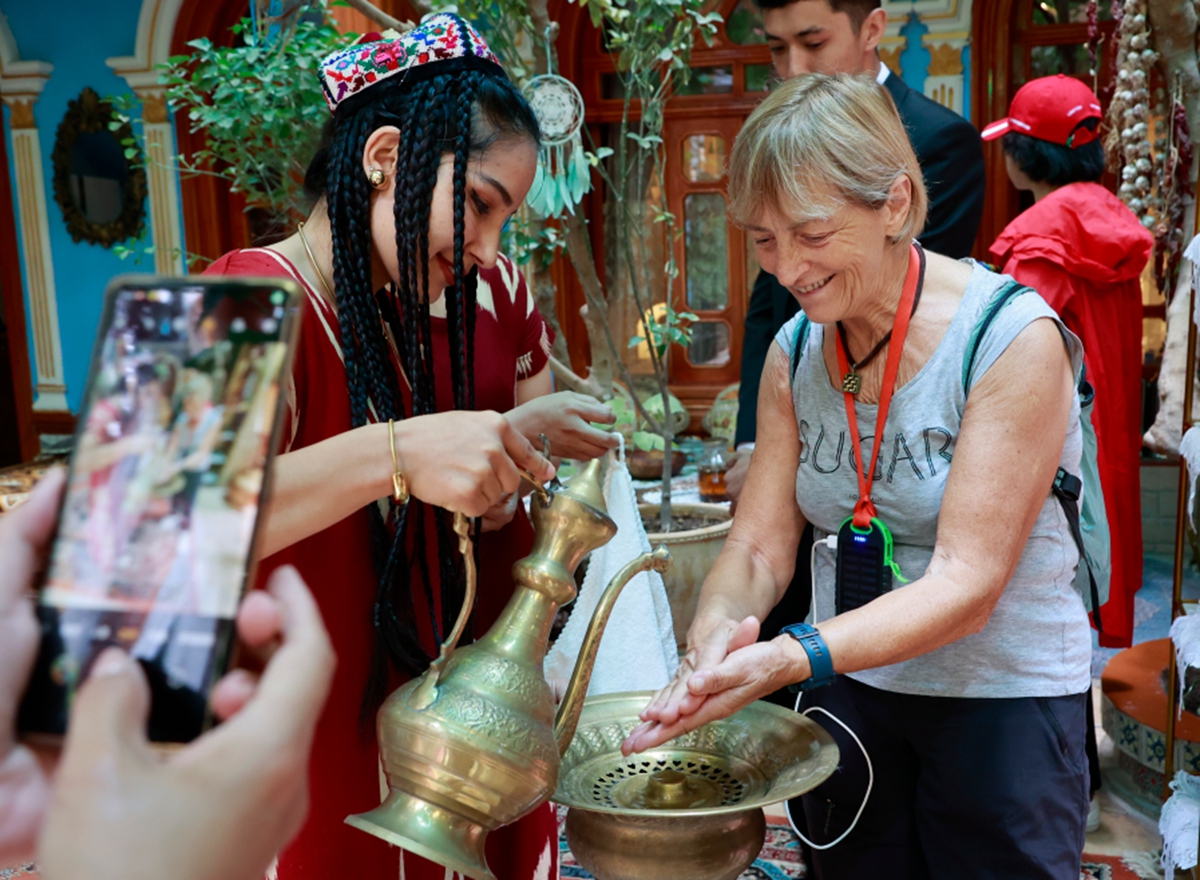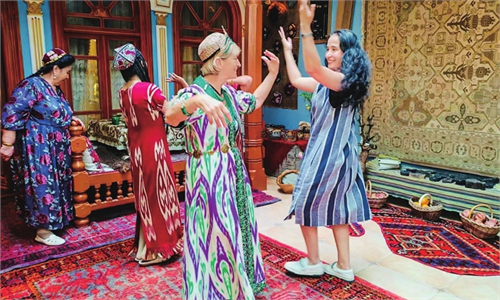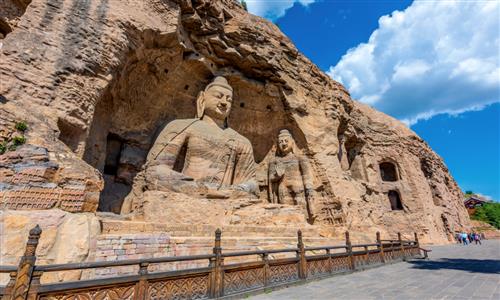ARTS / CULTURE & LEISURE
Italian trekker embarks on ‘Silk Road journey,’ sharing experiences in China with the world

Vienna Cammarota poses for a photo in Xinjiang.
The year 2024 marks the 700th anniversary of the death of Italy's famous traveler Marco Polo, and it has been 749 years since he first entered China. Over two years ago, a woman in her 70s, a follower of Marco Polo, retraced her footsteps along the Silk Road.After more than 850 days, traversing 14 countries across Eurasia, and covering 22,000 kilometers, some have called this Italian traveler, Vienna Cammarota, the "Marco Polo of the New Era."
In 2024, Cammarota arrived in China with The Travels of Marco Polo in hand. On August 29, "Vienna's Journey to China's Silk Road" officially kicked off in Kashi, Northwest China's Xinjiang Uygur Autonomous Region. With the guidance of the Chinese People's Association for Friendship with Foreign Countries and Bauhinia Culture Group, it was hosted by China Arts and Entertainment Group (CAEG) and the ACIS (Associazione Cina-Italia di Shanghai). Welcomed warmly by the Chinese people, Cammarota entered this long-dreamed-of land through the Irkeshtam port in Xinjiang.
Starting from Xinjiang, Cammarota will follow the ancient Silk Road, crossing more than 30 cities in 17 provinces, including Gansu Province and Shaanxi Province in Northwest China, East China's Fujian Province, South China's Guangdong Province, before finally arriving in China's capital Beijing. Along the way, Cammarota will immerse herself in the historical transformations along the ancient Silk Road over the past 700 years and share her experiences online, gaining over 100,000 followers. "I have personally experienced the connection, inheritance, and innovation between the ancient Silk Road and the modern Belt and Road Initiative. Through the exchange of culture and goods, people from all over the world are striving to break geographic barriers and create new prosperity, ultimately achieving cultural exchange and mutual learning," Cammarota said. She hopes to measure China's land with her own feet and share her insights on China with the world.
'A dream turns into reality'
Cammarota carries an old, well-read copy of The Travels of Marco Polo with her and writes down her observations in its blank spaces along the way. After stepping onto the Chinese soil, her annotations have become more frequent.
Kashi was Cammarota's first stop in China. Walking through the streets of the Ancient City of Kashi, she was deeply moved by its beauty. "When the lively scenes described in The Travels of Marco Polo appeared vividly before my eyes, it felt like a dream turning into reality," Cammarota said. Guided by local residents, Cammarota learned to play traditional instruments, make naan bread, and also tried local delicacies like cold noodles and pastries using chopsticks. "I'm still struggling with chopsticks, but I've made a lot of progress," she said.
During her journey, Cammarota habitually compares her experiences with the details recorded in The Travels of Marco Polo. She mentioned that the book describes vast cotton fields near Kashi. As she walked on the road to the Aksu Prefecture in Xinjiang, it was harvest season, and endless cotton fields stretched as far as the eye could see, filling her with joy.
"Many people called Marco Polo 'Mr Marco Millions' because the riches of the East he described - treasures, gold, silver, silk, and fields - were counted in the millions, which many people found unbelievable at the time. But after coming to China, I believe he wasn't exaggerating," she said.
In Kuqa county, Xinjiang, Cammarota entered a farmer's home to ask for some water, and the family welcomed her warmly. "An elderly man, about my age, picked a bunch of grapes for me. Just as the book describes, 700 years ago, the people here welcome guests with the sweetest grapes," she said.
In the Xinjiang Ancient Ecological Park in Xinjiang's capital, Urumqi, riders in traditional costumes on Akhal-Teke horses welcomed Cammarota's arrival. Cammarota approached one of the horses, gently stroking its mane, and said, "Seeing the Akhal-Teke horses described in The Travels of Marco Polo with my own eyes makes me so excited."
When visiting the Karez well system in Jiaoheyi (Jiaohe Courier Station) in Turpan, Xinjiang, Cammarota transformed into a tour guide, enthusiastically explaining to her companions, "This was once a place where ancient diplomatic missions and passing officials stayed, an inn for the emperor's messengers."
At the Aksu Museum, her attention was drawn to a map of the Silk Road. Standing before it, Cammarota couldn't help but recount Marco Polo's legendary journey and his enormous contribution to cultural exchange between the East and the West. In the museum's exhibition hall, Cammarota encountered a 12-year-old local boy from Aksu, who, filled with hope, expressed his desire to one day walk the entire ancient Silk Road himself. To encourage the boy to pursue his dream, Cammarota presented him with a souvenir from the "Vienna Cammarota's Silk Road Journey."

Vienna Cammarota (right) is warmly welcomed in Kashi, Xinjiang Uygur Autonomous Region.
'Ancient Silk Road fascinates me'September 8 marked the 846th day since Cammarota set out from her hometown of Venice, Italy. That day, Cammarota celebrated her 75th birthday at a Caucasian restaurant on the Eurasia Style Street in Urumqi. The vibrant Xinjiang-style singing and dancing, a feast of delicacies, and heartfelt birthday wishes touched Cammarota deeply. Draped in a silk scarf typical of Xinjiang, she was surrounded by Uygur women singing and dancing, and joined them in graceful dancing to the sound of an accordion. It was hard to imagine that this smiling woman, dancing happily, had once crossed the vast deserts and oases of Central Asia alone and climbed the towering peaks of mountains on the Pamir Plateau by herself.
Why Cammarota, at the age of 75, took such a grueling, long-distance journey to China?
Cammarota's longing for China probably began more than 20 years ago. At that time, a student from Beijing was living with her, and their time together sparked Cammarota's interest in China. From the year 2000 onward, Cammarota read The Travels of Marco Polo several times, trying to understand China through the book's descriptions. "The ancient Silk Road mentioned in the book fascinated me," she said.
In 2018, Cammarota had the idea of retracing the ancient Silk Road on foot - spending three to four years walking 22,000 kilometers, crossing 15 countries from Venice to Beijing. At first, when Cammarota's three children heard that their elderly mother was planning this, they thought it was a pipe dream. But when they saw her start exercising, researching routes, and purchasing travel gear, while also posting her plan online and receiving funding, her children gradually began to understand and support her.
On April 26, 2022, with a backpack containing The Travels of Marco Polo, the flag of Venice, a Chinese safety sachet, and other items, Cammarota set out from Lazzaretto Nuovo Island in Venice, cheered on by family and friends. She crossed Slovenia, Croatia, Serbia, Bulgaria, Georgia, Iran, Turkmenistan, Uzbekistan, Kyrgyzstan, Russia, Kazakhstan, and finally arrived in China.
How did Cammarota, at 75, manage to complete such a long journey?
Cammarota has great confidence in her health. Before retirement, she worked as a "natural environment tour guide," mainly leading tourists on hiking adventures. "I've never worn reading glasses, and my eyesight is still excellent," Cammarota said, adding that her commitment to walking has kept her in good health.
Typically, Cammarota maintains a pace of 15 to 20 kilometers a day. She jokes that with such intensity, she can often "finish the walk in one go." Along the way, she might have some water or a few nuts, and by sunset, she usually completes her day's journey. On this trip to China, Cammarota is still carrying her 20-kilogram backpack, which has accompanied her from Europe to Asia. As for her hiking gear, Cammarota has always kept things minimal, bringing only essential items like warm clothes, a solar charger, and a compass.
"The companions from the ACIS are always eager to help me carry the heavier bags so I can travel lighter," Cammarota said. "My main goal is to see how these places along the ancient Silk Road have changed, so equipment isn't the most important thing for me - just a few necessities are enough."
'Responsibility to show real China'
For over two years, Cammarota has been sharing her travel experiences on social media. People from around the world follow her story, accompanying her on the journey.
Cammarota has always wanted to share what she has seen of the real China on overseas social media, especially with Europe. "I found that the China reported by the state media in some European countries, including Italy, is completely different from what I see here. So, I have a responsibility to introduce the real China, to help more people get a more complete understanding of this country's history and culture."
"I can't help but imagine: When I return home and talk to my relatives and friends about China, the first thing I'll mention is China's highways, which are much more extensive than those in Italy," Cammarota said.
Every time Cammarota visits a new place in China, she writes detailed posts on social media. Some people have praised her as a "cultural ambassador for Europeans in China," while others shared their experiences of running into her on the road. Many overseas Chinese have also recommended local delicacies and scenic spots to her. Cammarota said that the most frequent word she sees in the comments is "brave," and this word has supported her throughout the journey.
In over two years, Cammarota has also witnessed the impact of the Belt and Road Initiative.
In Croatia, she visited the small island where Marco Polo is believed to have lived as a child and coincidentally passed by the Peljesac Bridge, built by a Chinese company. The bridge had been completed but not yet opened. Upon learning that her destination was China, the workers warmly invited her onto the bridge. The 2.4-kilometer bridge fulfills Croatia's long-held dream of connecting its northern and southern regions and links the island where Marco Polo lived to the mainland. "The Belt and Road Initiative is bringing everyone closer together," Cammarota said.
In Uzbekistan, Cammarota saw the Pengsheng Industrial Park, a joint venture between China and Uzbekistan. The park introduced Chinese drip irrigation technology to grow vegetables on a large scale, which significantly reduces labor costs while increasing production.
On the Pamir Plateau, Cammarota walked along the China-Tajikistan highway under construction, which is more than 1,000 kilometers long and expected to open in 2026. Locals told her about the 5-kilometer-long Shahriston Tunnel at an altitude of 3,000 meters, built by a Chinese company. The tunnel has connected areas once isolated by mountains, greatly facilitating local travel and earning the nickname "the best gift from Chinese friends."
As night fell, Cammarota stood on the rooftop of her hostel, gazing into the distance as if she could hear the ancient sound of camel bells on the Silk Road. Cammarota said that China's proposal of the Belt and Road Initiative builds on the ancient Silk Road. "I believe China can make even greater contributions to humanity in this regard."
Cammarota's journey in China has just begun, and in her interviews, she excitedly expresses her fascination with Chinese culture. She carries with her a set of Everyday Chinese books. "During my breaks, I'm studying this series diligently, and I hope to master some simple Chinese by the time I reach Beijing." Cammarota is also captivated by Chinese characters, which are completely different from Western alphabets. "China's culture and history are the spiritual fuel that keeps me moving forward," she said.



